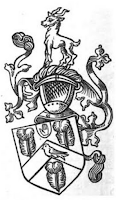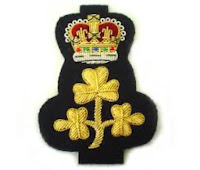The family of LYNCH was of great antiquity in the province of Connaught, being amongst the very early settlers, denominated the Tribes of Galway. In an old manuscript in Ulster King-of-Arms' office, William le Petit is stated to be the common progenitor of all the Lynches of Ireland.
The founder of the honours of the family, however, was
HENRY LYNCH, Mayor of, and MP for Galway (eldest of twelve sons of Nicholas Lynch, also Mayor of Galway).
Mr Lynch was created a baronet in 1622, designated of Galway.
This gentleman was the son of Nicholas Lynch fitz Stephen (Mayor 1584–1585) and great-grandson of Mayor Arthur Lynch (died 1539); land agent for Richard, 4th Earl of Clanricarde; mentor to Patrick D'Arcy and Richard Martyn, later senior political figures of Confederate Ireland.
He was stepfather to D'Arcy and married to an aunt of Martyn. He was among the first of his family to become a lawyer, and several of his younger sons followed him into this profession, as did, under his influence, D'Arcy, Martyn, Geoffrey Browne and subsequent generations of The Tribes of Galway.Sir Henry married Elizabeth, daughter of Richard Martin, and widow of James D'Arcy, by whom he had three sons and three daughters.
He died in 1635, and was succeeded by his eldest son,
SIR ROBUCK LYNCH, 2nd Baronet, MP for Galway Borough, 1639-42, and was resident counsel for Connaught during the rebellion.
He wedded Ellis, daughter of Sir Peter French, Knight, by whom he had two sons, and was succeeded on his decease, 1667, by the elder,
SIR HENRY LYNCH, 3rd Baronet, a lawyer of eminence, and one of the barons of the exchequer, in 1689, wedded firstly, Margaret, daughter of Sir Theobald Bourke, 3rd Viscount Mayo, but by that lady had no issue; and secondly, and had (with a younger son) his successor,
SIR ROBERT LYNCH (-c1720), 4th Baronet, who espoused Catherine, daughter of Henry Blake, of County Mayo, by whom he had, with two daughters, a son and heir,
SIR HENRY LYNCH (-1762), 5th Baronet, of Carracastle, who married Mary, daughter of John Moore, of Brees [sic], County Galway, and had one daughter and an only son, his successor,
SIR ROBERT LYNCH-BLOSSE, 6th Baronet, who wedded Elizabeth, daughter and heir of Francis Barker, heir of Tobias Blosse, of Little Belstead, Suffolk.
He assumed the surname of BLOSSE, in addition to, and after, that of LYNCH.
It was a condition of the marriage that Robert would assume the additional surname of BLOSSE and conform to Protestantism.
The issue of this marriage were, HENRY, who succeeded to the title; and Francis, who wedded Hatton, daughter of John Smith, and had issue, Robert, who, succeeding his uncle, became the 8th Baronet.
Sir Robert died in 1775, and was succeeded by his elder son,
SIR HENRY LYNCH-BLOSSE, 7th Baronet (1749-88), MP for Tuam, 1776-83, upon whose demise, without issue, the title reverted to his nephew,
SIR ROBERT LYNCH-BLOSSE, 8th Baronet (1774-1818), who wedded firstly, Elizabeth, daughter of William Gorman, of Carlow, by whom he had FRANCIS, the next baronet, with several other children.
He married secondly, Charlotte, daughter of John Richards, of Cardiff.
Sir Robert was succeeded by his son,
THE REV SIR FRANCIS LYNCH-BLOSSE, 9th Baronet (1801-40), who wedded, in 1824, Elizabeth, eldest daughter of Lord Plunket, and had issue,
ROBERT, 10th Baronet;
William Conyngham, b 1826.
*****
Sir Richard Hely Lynch-Blosse (b 1953), 17th and present Baronet, lives in Oxfordshire.
ATHAVALLIE HOUSE, near Castlebar, County Mayo, is a long, low, plain, two-storey residence, its main block of five bays, with an entrance door set in a broad stone arch.
The front is extended by a four-bay range of the same height, though set back.
In 1894, Athavallie House was recorded as the seat of Sir Henry Lynch-Blosse, 11th Baronet (1857-1918), and most likely the last of the family to reside there.
In 1920, the Sisters of St Louis founded a school which catered for girls only.
It was a boarding school-cum-day school until the St Louis Sisters left in 1978 and the school became co-educational under the control of the local community.
Balla Secondary School is based here now.
Athavallie House still stands but is no longer used for educational purposes.
It was used as a military hospital during the 1st World War.
Other former seat ~ Castle Carra, County Mayo.
First published in April, 2013.



































